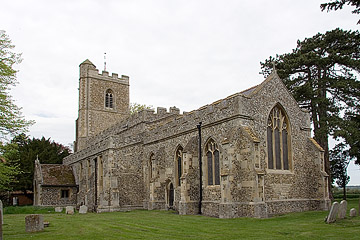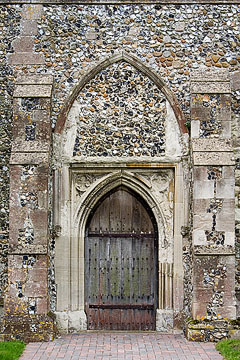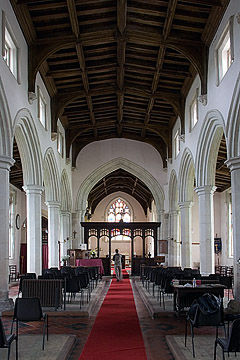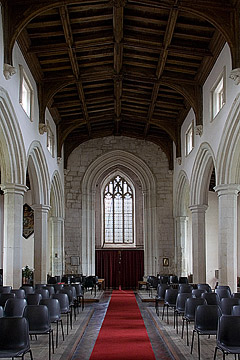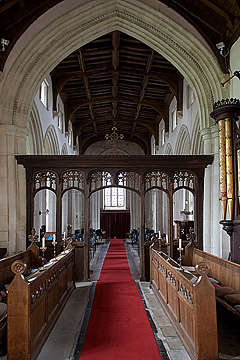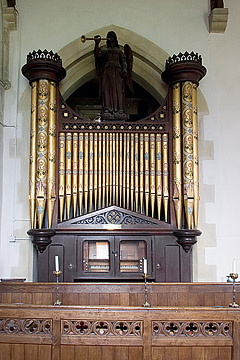We had some difficulty getting into St Mary. To start with, the door that faces the path up from the road has neither handle nor keyhole, which is a bit disconcerting. It turns out that the entrance is on the other side, and is reached by a gravel path that looks like it's just a driveway for the houses immediately to the west of the graveyard. After solving this conundrum, we then found - much to our irritation - that the church was locked, with neither keyholder information nor any contact details for vicar or churchwardens. Now, as it happens, we were lucky: there was someone working in the graveyard who, after interrogating me a bit about why I wanted to get inside, got a key and opened the door for me. Travellers in our footsteps may not be so lucky, though; and they really ought not to need to be lucky. Inside, I found that the previous entry in the visitors' book was from 2001 - over five years prior to our visit - and asked 'I wonder why more people don't visit this lovely church?' Perhaps it's because the parish make it so very difficult for them to do so…
As it happens, it's not one of the most interesting churches in Cambridgeshire, so the difficulty getting inside St Mary isn't quite as irritating as it is at Bottisham, or Leverington, both of which are magnificent public works of art, and should be throwing their arms wide in celebration and welcome. That's really not the point, though: there's a strong religious reason to keep a church open, or at least to provide information about how to get inside. Even aside from what it says about the parish's attitude towards its Christian mission, keeping a church inaccessible is entirely at odds with the fact that the Church of England is still the established church in this country. Some parishes seem to regard them as private places of worship for the dwindling local congregation and guests. This, I take it, is the assumption behind the complaints one sometimes gets in response to rants of this sort: 'Why don't you come and visit us on a Sunday morning and join in our service? Then you could see the church'. Well, the answer to that is this: I really don't want to. And, since (madly, in my view) the Church of England is still established, nor should I have to: it should keep its places of worship open to everyone who wants to make reasonable use of them, and the local custodians of those buildings have no right to demand that one only sees them in the context of their religious services.
People want to visit these buildings for a whole host of reasons: for private prayers, for silent remembrances, for moments of swift solace, for a sense of history, or through a love of architecture, or to rest in their memories. Why then should their churches be closed to them? It's no business of the Church what motivates people to seek out these buildings. Francis Bacon famously praised Elizabeth I's religious policy by noting that the did not like to make 'windows into men's hearts': why then should the custodians of the tradition she formed try to do the same?
Much of this complaint isn't directed against Whaddon specifically: as I've said, a local man was very happy to let us in to have a look around. Still, it would be nice if more people were, like Mark and I, and our predecessors in 2001, able to stop in to appreciate this quiet building.
St Mary mostly dates from a substantial Perpendicular rebuilding in the 14th and 15th centuries, although there are some 13th century bits that survive inside. The exterior, however, looks depressingly Victorian. By the middle of the 19th century, St Mary was in a parlous state, and two big restorations of 1868 and 1873 have given it something of a sterile atmosphere. The walls are built of flint and pebbles, with battlements that are crisp and mechanical. The windows have square heads and very new-looking tracery (though there's some dispute about these windows, as I'll say later).
The tower - the upper part of which was rebuilt slightly later, in 1894 - has a little square stair turret and a clock, but for some reason the proportions just don't seem to work properly. A few details lighten the sombre Victorian mood, though. The little faces that support the clerestory battlements, for example, are clearly medieval; and the north door (the one with no keyhole or handle) provides a little architectural conundrum: it is set inside a 15th century frame, which is itself set within an older and much higher arch, most of which is now filled up with the same flint as most of the walls. Was this a porch, I wonder, or just an older doorway which was closed off for some reason?
Inside, the impression one gets is slightly better. The nave is a lovely space, with five very tall bays. Some of the arches are from the original 13th century, but they were significantly heightened on plain octagonal piers in the 14th century. The height of these arcades, and the relatively low clerestory, combine to lessen the distinction between the nave and aisles: this church feels very wide and spacious. The tower arch is also very tall and unadorned, and frames a fine sharp Perpendicular west window (which, unlike most of the windows here, looks like it might even be original). Nearby, at the end of the north aisle, there is a contemporary font. Like the other 15th century work here, it is relatively plain: the only decoration is sober panelling on the shaft and seven faces of the bowl. The eighth, which faces east, has a carving of the shield of the d'Eschallers family, who were lords of the manor here between the Norman Conquest and the 15th century.
As I mentioned earlier, there's a conundrum about the windows. The aisle windows are especially odd, and very hard to date: they are tall, square-topped things, with two thin lights each divided into two panels by transoms, and surmounted by tracery that sometimes seems to be Perpendicular in form, and sometimes displays rather earlier flattened ogival shapes. The church guide claims that they are 14th century, and Pevsner seems to agree, but I'm just not sure I can swallow it (and Pevsner is, at any rate, certainly wrong about the date of the tower, which he claims to be entirely Perpendicular). At the very least, those aisle windows were very heavily recut by the Victorians: the stonework is not five hundred years old. Given that, though, I wonder what reason there is to think that the peculiarity of the design is not a faithful reproduction of the original, but rather an artefact of Victorian whimsy. The same goes for the clerestory windows, which are quatrefoils set within deep square frames, and whose apparent dating to the 15th century is likewise suspicious.
Perplexing windows aside, the clerestory also sports some extremely good corbels for the roof. The mason here seems to have decided to terrify the congregation with a collection of monstrous animals and some extremely anguished looking people, with Munch-style screaming mouths and boggled eyes. They support a roof which contains some massive old tie-beams and some nicely carved bosses.
The chancel arch is another survival from the older building, and appears to be almost transitional in form: the arch is broad and pointed, and contains a line of dogtooth decoration in the moulding on the eastern face. The jambs are quatrefoils, and lean slightly inwards. Within the arch is a rood screen, a fair amount of which is original medieval woodwork. It is divided into six lights, the middle two of which are combined into a doorway with an ogeed arch over the top. Above that arch are two further arches filled with spiky trefoil tracery, matching that at the top of each of the openings on either side. Above those, the rood beam is restored, but the dado panels below appear to be ancient. They are decorated with blind arcading and carved spandrels, one of which is in the form of a bird with delicately carved feathers.
The chancel itself is small, and somewhat dominated by the organ set into an arch in the north wall. It's a fine organ, as it happens: lots of burnished pipes covered in stencilled flowers and bows and things. It is surmounted by a statue of an angel blowing a trumpet - a smaller cousin of the spectacular carvings on the organ in King's College chapel.
The organ was placed there during the big restoration of the church in 1868-9, and this required moving a chest tomb, which now sits just to its east. It has a very worn clunch base decorated with shields and blank arcading, and a rather pitted black marble slab on top. At one point, I suspect, the slab contained a brass, for although the surface is so degraded that it's impossible to see whether there was ever a figure in the middle, there are depressions for shields in the corners. A sign indicates that this is the tomb of John, last of the d'Eschallers, who died in 1469.
Further along the north wall is a blocked up priest's door, in front of which is a table displaying a copy of the English Liturgy and an old wooden flute. The latter has a handwritten label saying 'This instrument was given to the parish church of Whaddon by Mr Fred Jackson, whose grandfather Stephen used it to accompany the singing in the church before the organ came to the church.' While musing on this cheerful fragment of history, we noticed another unusual touch. Behind the altar is a marble pavement of black and white slabs punctuated by little blue tiles, which are decorated in gold and white and depict the instruments of the passion. I don't know what age it is, and it doesn't really matter. The sad thing about most of the Victorian restoration is the soulless regularity of it, which sits at odds with the vivid details surviving from the medieval craftsmen, in the corbels and the screen and the faces outside on the battlements. The charming images on the pavement - a plain white robe framed by three tiny dice, for example - belong in that tradition, and for that reason their age is immaterial. I wish that more people were able to get in to see them…
St Mary appears to be kept locked, with no details of how to get in.
